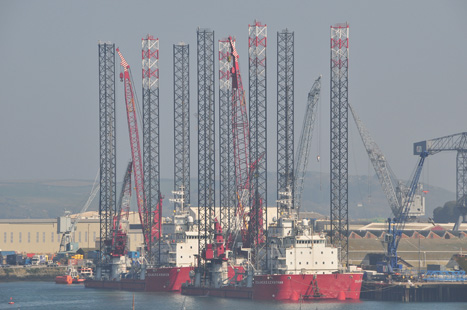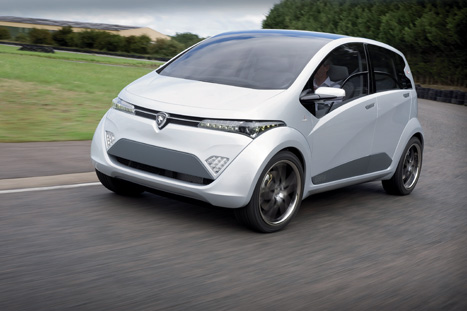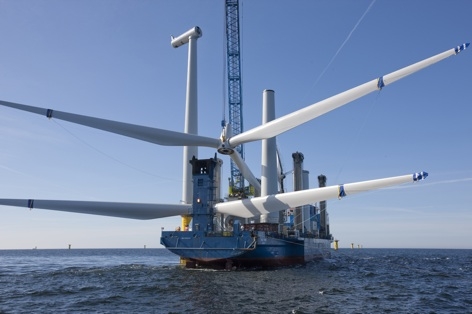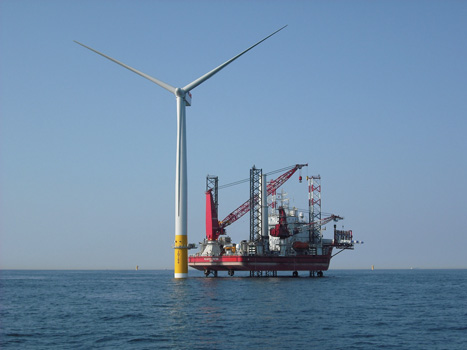
Dawn is beginning to break in Cornwall and the Leviathan and Kraken, two grand vessels, sit patiently awaiting their departure from the historic Falmouth docks. Both veterans of the rough seas, they have battled extreme conditions in the search for oil and gas, and now, perhaps for the final time, they are being re-armoured for what will be one of their most challenging missions to date.
The crew has less than two days to prepare the ships for their journey to the Irish Sea, where they will install 51 wind turbines for the Walney 2 offshore wind farm. It’s a difficult task that will stretch the vessels, as well as the engineers on board, beyond anything they have experienced on previous oil and gas operations. With the sun coming up and the final touches still to be made, the dockyard transforms into a frenzy of hard hats and high-vis jackets.
“The whole industry is still adapting… we can learn a lot from offshore platforms”
’It’s been a very busy two weeks, there were no bank holidays for us,’ said Jim Prior, chief engineer on the project, as he hurried towards the ships. The activity is a welcome sight for many at Falmouth who have seen their fair share of job losses. Dockyards, once magnificent examples of British engineering, became barren sites as increased competition and political circumstances led to a dramatic decline in shipbuilding contracts.
But now, with the emergence of the burgeoning offshore renewables industry, shipbuilders and repairers up and down the UK’s coastline are working to adapt their skills and expertise towards offshore wind, wave and tidal projects.

For ship repairers A&P Group this means converting self-propelled jack-up vessels, owned by Norfolk-based company Seajacks, to install wind turbines in the waters surrounding the British Isles. Work so far has involved the construction of 100-tonne blade racks allowing each ship to carry components for two turbines at a time. The project, claimed Prior, has helped revive some long-buried shipbuilding skills, as well as bringing some of its own unique challenges.
While the initial construction of the blade racks is relatively simple, at sea, engineers have to contend with the difficulties of weight. To install the wind turbines, both jack-up vessels will manoeuvre themselves into position using dynamic positioning. Powerful jack-up legs are embedded into the seabed and raise the vessel to 25m above sea level. The main crane then offloads three separate sections of the turbine tower for installation, weighing around 100 tonnes each.
’The depths the legs can go to in the mud, as well as the weight we’re carrying, can cause quite a problem,’ said Prior. ’During the last project, we were getting stuck for up to two days at a time.’ Sinking up to 13m under the enormous weight of the turbines, these delays are not an option at Walney 2. The team is now able to address the problem by spraying seawater into the high-pressure vacuum that forms between the legs and the seabed and keeps the ship in place. Once the vacuum is broken, the ships buoyancy should then be enough to pull the legs out.

’The whole industry is still adapting,’ said Prior. ’We can learn a lot from other offshore platforms, which have been going for years, but we also have our own lessons to learn, particularly with building the turbines… It can be challenging, because these are enormous pieces of equipment that weigh a great deal. The industry could do worse than take the lead from the oil and gas industry, where the offshore services division of the HSE [Health and Safety Executive] has been regulating their operation successfully for the last 25 years.’
Two hundred miles east and BAE Systems Surface Ships is carving its own niche for the offshore renewables market by developing new devices. Among other projects, it has worked with the Energy Technologies Institute to design a 5MW floating wind turbine structure. It is also working with wave energy developer, Aquamarine Power, as part of a project worth £1m to develop and commercialise the company’s Oyster wave energy converter.
’There are a number of parallels between shipbuilding and some of the things that we need to get right for wind, wave and tidal,’ said Jon Mills, energy project director at BAE. ’In our core business we need to keep large complex ships and submarines operating at peak performance throughout their life in harsh marine environments, and that’s the same with offshore renewables. We’re still testing the water and we’ve started doing some work to prove to ourselves that we do bring some value to the market.
“People don’t tend to consider the UK for shipbuilding but that’s on a reputational basis”
As well as both industries working in hostile ocean environments, the understanding of large structures, too, is a crucial skill that can be transferred from shipbuilding. But Anders Mikkelsen, wind turbine installation lead at Siemens, believes that the similarities shouldn’t be exaggerated. ’What we really need is people that have a bit of technical flair and who know how to use their hands,’ he said. ’There are a number of industries we recruit from, shipbuilding one of them, but the challenges are unique and we still train our own guys.’

Location, however, is one area in which shipbuilders and repairers can gain an advantage in the renewables market. Shipyards are well placed for the construction of offshore renewable technologies. They also have the space and some of the equipment required for the construction of these structures. According to Jamie Grimwade, marine renewable technical specialist at the National Renewable Energy Centre, while vessels can travel easily from one port to another after construction, transporting turbines is more labour intensive so it’s important to consider manufacturing them closer to where they’ll be deployed. And while it’s further from the skills of shipbuilders, Tony Cato, captain of the Leviathan, believes moving towards fabrication of turbine structures, rather than the conversion of support vessels, is a wise strategy. Both the Leviathan and Kraken were built in Dubai rather than the UK, and Cato predicts that trend will continue as larger offshore wind turbines demand custom-built ships for installation.
“People don’t tend to consider the UK for shipbuilding but that’s on a reputational basis”
’The fact of the matter is it’s cheaper to build ships elsewhere, and while we still do a lot of repair and conversion work, we no longer have the capacity to build in the UK,’ he said. ’The government has already committed to putting millions back into various ports and into boosting the offshore renewables industry. There is no shipbuilding left in the UK, so that money should boost the manufacture of wind turbine structures in and around those ports.’
But Patrick Carnie, strategy manager at the Marine Industries Leadership Council, disagrees. He believes that the UK’s reputation in shipbuilding has been damaged following a decline in activity, but the skills and capacity to build the colossal ships required for the next generation of offshore wind turbine installation are still there. ’People don’t tend to consider the UK for shipbuilding but that’s just on a reputational basis,’ he said. ’We have the infrastructure, but we need to get that reputation back.’

Against the tide: the Oyster wave energy convertor at work
At the moment, the UK is leading the global market in offshore renewables just as it once was in shipbuilding. But once again, the rest of the world is quickly catching up. Governments in Norway, Canada, Germany and France have come together to develop shared strategies to improve their industries and, with the offshore market expected to generate £170bn a year by 2050, competition to gain a slice of the market is intense.
During the First World War, prime minister David Lloyd George once said: ’The road to victory is found in one word ships; in a second word ships; in a third word ships.’ He was right in more ways than one. The fall of British shipbuilding devastated the UK’s dockyards, lost valuable engineering expertise and damaged a historic legacy. But now Britain’s remaining shipbuilders and repairers have a second chance to use their skills in an exciting area of emerging technology. If they succeed, victory for the UK could be extremely lucrative.
Good tidings
Siemens and ABP pledge to build the UK’s first offshore wind turbine manufacturing facility in Hull
Last year, the government announced plans to inject £60m of funding for offshore wind manufacturing facilities at port sites. According to the Carbon Trust, the funding could create 70,000 extra jobs throughout the UK.
This money, however, is yet to be dished out. A spokesperson for the Department of Energy and Climate Change said: ’There is going to be that money for offshore wind port infrastructures we haven’t allocated it yet but we’re speaking to various companies that are interested in coming to the UK.’
Since then, German engineering group Siemens and Associated British Ports (ABP) have announced that they will construct what will be the UK’s first offshore wind turbine manufacturing and export facility at Alexandra Dock in Hull.
It’s estimated that the project will create 10,000 jobs in the region, fuelling hope for the government’s goal of creating opportunities in the ’green economy.’
For Siemens, which currently employs 16,000 people in the UK, the project is expected to significantly increase its UK business, which had revenues of £4.1bn last year.
On a recent visit to the Hull site, deputy prime minister Nick Clegg said: ’Hull is ideally located to support offshore wind developments and is well placed to become a UK centre of excellence in the developing renewable energy sector. There is huge potential here to create jobs and apprenticeships and help us create the new, green economy Britain needs for the 21st century.’
Distant Shores
The largest Seajacks vessel yet will be built in a shipyard in Dubai
Captain Tony Cato of the Seajacks Leviathan believes that future wind turbine installation vessels will not be built in the UK due to lack of capacity.
His company has already entered into a contract with Lamprell shipyard in Dubai to build a new vessel, the Zaratan, which is expected to be completed in 2012. The ship will be 60 per cent larger than current vessels and able to carry up to four turbines.
’Leviathan and Kraken are at their limit right now,’ he said. ’Phase 3 of the UK’s offshore wind plans hasn’t really started yet, but when it does, the difference in size between it and the first two rounds, in terms of wind turbine installations, will be monumental and we need ships that can handle that.’




Project to investigate hybrid approach to titanium manufacturing
What is this a hybrid of? Superplastic forming tends to be performed slowly as otherwise the behaviour is the hot creep that typifies hot...